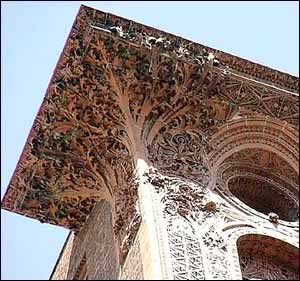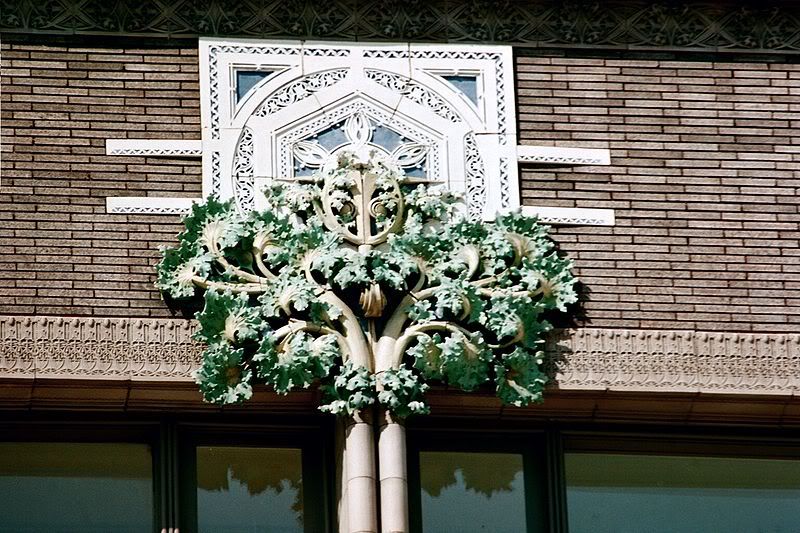I can no longer hide my true feelings of impression and admiration for you. When I first laid eyes on you, I knew you'd be the sculpture-my sculpture- with your resonating motifs reminding of the sweet agony that was art history. At first glance, you seemed more like a fence placed in the corner to hide the strange piece of artwork. Too close to the ground for the designs in the interior to be appreciated and further studied, I wondered why you might even be considered a sculpture at all because quite frankly you resemble a weathered fence that had no other place to go. It seemed even the university sought to hide you on low on the concrete wall, behind the overgrown foliage and shade of th
 e looming tree. Alas the more time I spent outdoors with you only made me appreciate your presence for what it truly was; a decorative ornament with enough calming qualities to make a casual passerbyer feel comfortable to enjoy the outdoors. Manmade married with natural motifs, you work to bring together these two aspects to ease a, for example a student, into the natural world though they are surrounded by the hustle and bustle of a city and large university. What I'm trying to say is, you make life easier for anyone struggling and finds themselves in your particular niche of the sculpture gardens by creating a relaxing ambiance.
e looming tree. Alas the more time I spent outdoors with you only made me appreciate your presence for what it truly was; a decorative ornament with enough calming qualities to make a casual passerbyer feel comfortable to enjoy the outdoors. Manmade married with natural motifs, you work to bring together these two aspects to ease a, for example a student, into the natural world though they are surrounded by the hustle and bustle of a city and large university. What I'm trying to say is, you make life easier for anyone struggling and finds themselves in your particular niche of the sculpture gardens by creating a relaxing ambiance.
Tragedy darkens your past, but helped me further understand you and what your creator, Louis Sullivan, attempted to do with your design. The intertwining, vegetative motifs on your shaft were a signature of Sullivan in helping him reflect the interior of a building, paradoxically, in a humanistic natural way. I had so many questions about why you were being used as a decorative piece when you were meant to be a functional piece, but none of my questions were answered. Rather I found out that many other architectural pieces done by Sullivan were destroyed after World War II and only a few rare pieces survived destruction. Miraculously, you were saved from the front of the department store you adorned and were given to the Institute of Art in Chicago, until you were eventually donated to your present home at the university. Therefore, you are a rare piece of history gracing the university for the education and appreciation of the students. The fact that you represent such a successful man that is still considered the father of modernism and inventor of the skyscraper, makes you a kind of ambassador for the students coming to study.
My interest was sparked when I began to realize that you weren't simply a fence but were mounted and placed a concrete wall for a particular reason. Maybe you had strictly been transformed into an art piece rather than the functional piece you used to be while in Chicago. The way in which you were arranged was interesting because the gap between each separate baluster was huge. Too large to be used as a functional piece because a person would be able to fall through if they were used as a fence or as actual balusters. The balusters had been arranged to frame the concrete behind it, giving the piece more texture. The fact that the balusters would be framed by metal that was not originally part of the work and concentrating on more than the balusters within the frame, shows the intention to be used and seen as a piece of art. The frame focuses the attention on the balusters, though it plays an important role in connecting the architectural pieces to the world of art.
Placement is key in the relaxing atmosphere that you give off in the garden. You do not sit in the line of sight of a person and are tucked in the corner, but all for a clever reason. You are a piece of art that does not push yourself on the minds of people, rather you let them see and appreciate you on their own terms. Something I find quite endearing, especially since they would most likely come to this quaint place to study or enjoy a peaceful lunch. You lie at a level that many would never take much notice until they sit down on a bench that would be in the vicinity. Like a panther you hide in the shadows, until someone casts a sideways glance and begins to see the artistry hidden by the shadow and positioning.
Organic line, whether intentional or not, plays another huge part in the calming artistic appeal. Your structure as a whole has no geometric or sharp lines, providing an artistic element that is easy on the eyes of whomever look upon your beauty. Initially the organic line used in your “outline” invites a casual observer to move their eye inward to the true motif of your body, revealing the artistry of your former functionality. Intertwining vines dominant your surface with a few oval shaped disks, resembling those found on family crests. Organic line conquering the design on your surface is simplistic and “toned down,” creating an earthy feel. Earthy in the way that you somehow belong to the space you inhabit, with almost every aspect of you being a subtle beauty shyly flirting with nature.
The natural motifs show the inspiration of your creator, showing the natural beauty even on them manmade. Resonating motifs invading almost the entire baluster connects your cast iron with foliage surrounding you. Imitating nature in an artificial way you connect the viewer to nature by falsely separating them, giving a sense of security to people who are more likely than not used to nature. With every part of you toned down, creating a feeling of serenity while next to you, the sculpture garden has been graced by your placement. I have spent so much time with you, but have not revealed my devotion to you until now.....well flattery is the highest form of flattery, so to prove my love to you I will strike the most graceful baluster pose I have ever struck. I hope you like it!
XOXO
Erin
